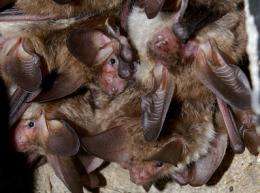Bats with high social intelligence

Scientists agree that living in complex social systems with individualised relationships doesn’t work without a high degree of socio-cognitive skills. Elephants, dolphins and primates live in complex social systems and have relatively large, highly developed brains. Research has never associated bats with such characteristics, however, even though they sometimes live in huge colonies.
A long-term study of a colony of Bechstein’s bats now challenges this assumption: the bats cultivate long-term, stable personal relationships with other individuals and can form networks with friends and relatives, scientists from the University of Greifswald and ETH Zurich have now revealed in a paper just published in Proceedings of the Royal Society B.
A small network of family and close friends
For the study, the German evolutionary biologist Gerald Kerth from the University of Greifswald spent over twenty years amassing a vast amount of data on the social lives of Bechstein’s bats in two colonies with sixty animals in all. Over the last five years he has been collecting data by fitting every single bat with an RFID chip and thus monitoring fully automatically where which animal resided in its summer quarters. In some cases, autonomous cameras recorded images from the roosts. The researchers were looking to use the data to find out which individuals a bat cultivates relationships with.
In analysing the data – 20,500 records in all – ETH Zurich researchers Nicolas Perony and Frank Schweitzer, Professor at the chair of Systems Design, discovered that the two colonies didn’t intermingle. The larger colony of forty animals formed two subgroups of about twenty animals that were in closer contact with each other. Within these groups, Perony and Schweitzer were able to discern a close, distinctive friendship network. Only females that are normally related to each other in one line, i.e. grandmother, mother and daughter, belong to such a network. These are joined by “friends of the family”.
Daily routine masks relationship patterns
The researchers were amazed that the relationships lasted even though the animals didn’t cultivate them on a daily basis. Every day, the bats regrouped in their roosts, so the scientists were only able to discern the relationship patterns by analysing contact data over longer periods of time. “The relationship patterns are hidden”, says Perony. “If you consider the group structure of individual days, you can’t tell who’s in contact with whom.”
Old females up to twenty years of age played a special role in the cohesion of the individual group and the large colony. On the one hand, they ensured the exchange between the groups; on the other hand, they always took their daughters and granddaughters with them when they joined another formation.
The studies in the bat colonies were carried out from April to September because that’s when the females congregate to raise their young. Where the Bechstein’s bats hibernate is not known. However, in the spring the same individuals reconvene at the same place. Just how the mechanism of recognition works, the researchers don’t know. They observed that bats rub their noses against each other. Maybe the animals recognise each other from their smell. According to Gerald Kerth from the University of Greifswald, they may well also communicate through calls.
Brain size and social system not linked
What astonished the researchers was that the complex social structure within the bat colony doesn’t tally with the presumed cognitive skills of the animals. “The study sheds a whole new light on the connection between complex social systems and brain development”, says Frank Schweitzer, a professor of system design at ETH Zurich. That bats behave so socially despite their small brains suggests that the connection between social complexity and cognition in mammals could be weaker than previously thought. “In that case, the word intelligence has several meanings; bats obviously have a high level of social intelligence.”
Neither Nicolas Perony nor Frank Schweitzer is a zoologist. However, the Bechstein’s bat served as an excellent study object for them to research the basic structures and dynamics of social interactions. “We want to know how social networks are formed, work and help a community to succeed”, explains Schweitzer.
For analyses of this kind, the ETH Zurich researchers need long-term data, which Gerald Kerth was able to give them. His data covers a time span of twenty years, five of which with high temporal and spatial resolution, which makes the data very valuable for the ETH Zurich researchers. “The bat data from the last five years would correspond to about twenty-five years’ worth of data on people”, says Nicolas Perony.
More information: Kerth G, Perony N, Schweitzer F. Bats are able to maintain long-term social relationships despite the high fission-fusion dynamics of their groups, Proc. R. Soc. B 2011,
Provided by ETH Zurich

















